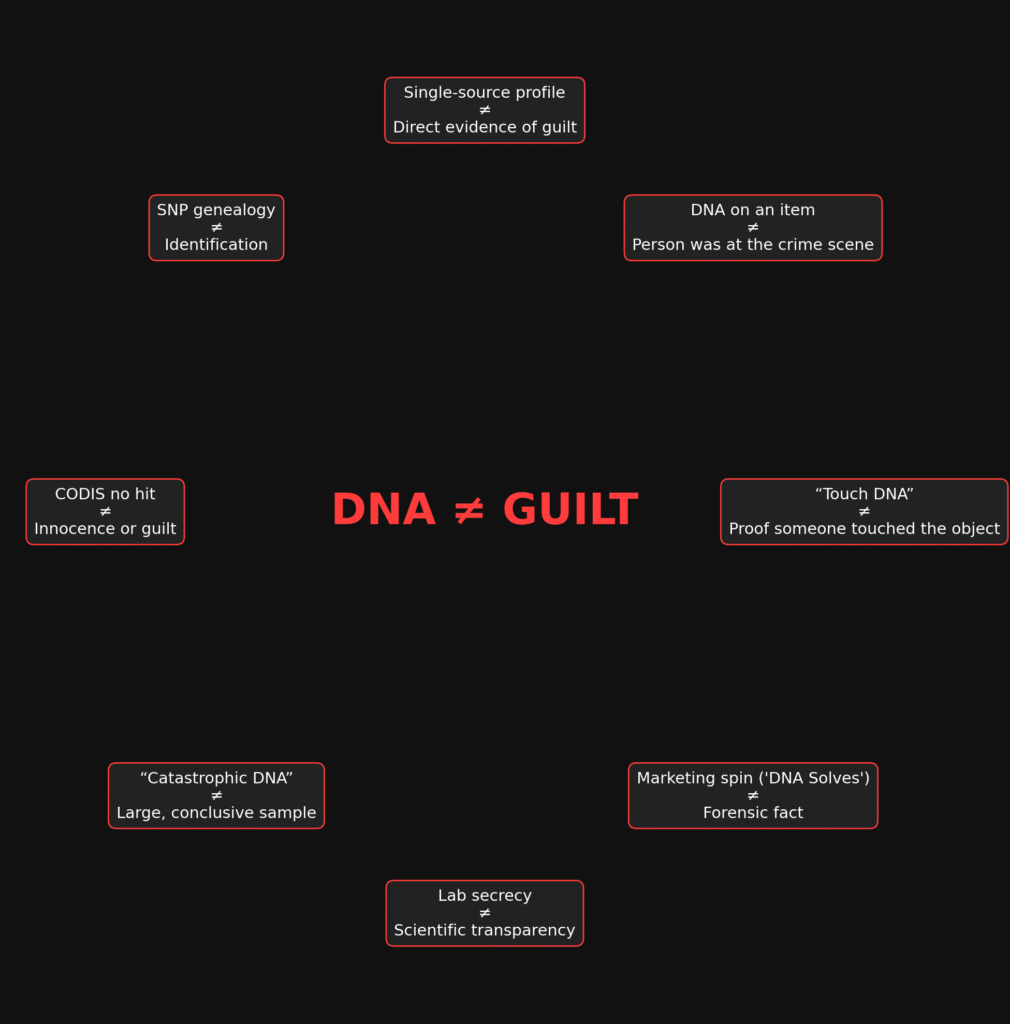
DNA Contradictions: What the Idaho4 Case Teaches Us About “Touch DNA”
Mainstream coverage of the Idaho4 case has turned the sheath DNA into a kind of myth. Fox News even called it “catastrophic” and “tons of DNA,” suggesting it was overwhelming proof against Bryan Kohberger. But the actual court filings tell a different story, one filled with caveats, restrictions, and warnings from judges about misleading terms.
The truth is simple: DNA evidence is powerful, but it’s also easy to oversell. Courts themselves have acknowledged that low-level samples don’t prove direct contact, presence at a crime scene, or guilt. Let’s break down the contradictions.
⚖️ The Visual Analogy: DNA ≠ What They Claim
- “Touch DNA” ≠ Proof someone touched the object
→ DNA can transfer second-hand (through another person or object). - DNA on an item ≠ Person was at the crime scene
→ DNA persists; it could have been deposited days, weeks, or months earlier. - Single-source profile ≠ Direct evidence of guilt
→ It only means the profile is consistent, not that the person left it. - SNP genealogy ≠ Identification
→ SNPs generate investigative leads; STR confirmation is required. - CODIS no hit ≠ Innocence or guilt
→ It only means the DNA wasn’t in the national database – nothing more. - “Catastrophic DNA” ≠ Large, conclusive sample
→ In Idaho4, the sheath trace was 0.0168 nanograms – less than a single cell. - Lab secrecy ≠ Scientific transparency
→ The State refused to release raw SNP/STR files, citing Othram’s “contractual restrictions”. - Marketing spin (“DNA Solves”) ≠ Forensic fact
→ Not all DNA solves; some DNA only confuses, misleads, or points to the wrong people.
Why This Matters
In Kohberger’s case, the only probative DNA was from the snap of a knife sheath. That single trace returned no CODIS hit. Investigators had to send it to Othram for SNP genealogy, and only then did the FBI generate a tip with Kohberger’s name.
The defense repeatedly asked for the raw lab files to evaluate the work, but the State refused, saying Othram’s records were proprietary. Judges even banned use of terms like “touch DNA,” “contact DNA,” and “trace DNA” to keep the jury from being misled.
Yet in 2025, we’re told in headlines that there was “catastrophic DNA” everywhere. That simply isn’t true.
The Bigger Picture
The danger here isn’t just one case. It’s how marketing and media spin can distort what forensic science actually means. By equating a microscopic, ambiguous DNA trace with absolute proof of guilt, the justice system risks wrongful accusations and convictions.
Investigative genetic genealogy (IGG) in particular is not identification – it’s a lead-generating tool. But when presented as “DNA solves,” the public and even jurors may be misled into thinking it’s definitive.
Closing Thought
DNA evidence is a tool, not a magic bullet. And as the Idaho4 case shows, DNA ≠ guilt. Until courts, labs, and the media stop inflating what DNA can prove, we risk turning a powerful technology into a weapon of injustice.